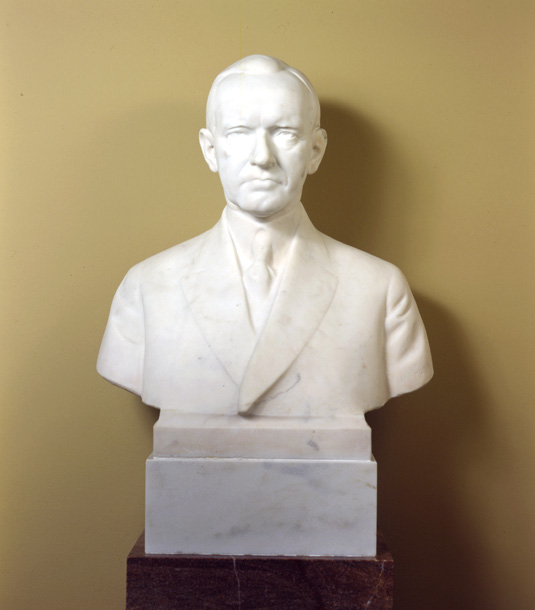
| Title | Calvin Coolidge |
| Artist/Maker | Moses A. Wainer Dykaar ( 1884 - 1933 ) |
| Date | 1927 (carved), 1924/1925 (modeled) |
| Medium | Marble |
| Dimensions | h. 27 x w. 23 x d. 12 in. (h. 68.6 x w. 58.4 x d. 30.5 cm) |
| Credit Line | U.S. Senate Collection |
| Accession Number | 22.00029.000 |
During the first few months of President Calvin Coolidge’s administration, the chief executive sat for sculptor Moses Dykaar at the White House. Dykaar, who also sculpted First Lady Grace Coolidge, exhibited models of the first couple at the Smithsonian Institution in Washington, D.C., in January 1924. According to the Washington Herald, “The bust of Coolidge is to be executed in marble, which Moses Dykaar himself will cut...[and] is destined for the Capitol.” However, it was not until two years later that Dykaar was contracted for a marble bust of the president for the Senate’s Vice Presidential Bust Collection based on his plaster model. The sculptor had earlier executed a bust of Thomas Marshall for the Senate for which he had been paid $1,000–a fee $200 greater than was customary, due to increased transportation costs for marble during World War I. Dykaar again received the higher commission price for the bust of Coolidge.
Dykaar, a Lithuanian-Russian immigrant, had attended drawing school in his native Vilnius, later studying at the prestigious Academie Julian in Paris. Preferring his subjects to be animated while posing, Dykaar had difficulty with the taciturn Coolidge, who sat “silent as the Sphinx.” But Coolidge did provide a few lighter moments. A 1931 article discusses the sittings: “Sometimes Coolidge would tell a joke, in his cold, grim Yankee way, but he was at his best when he wiggled his ears.” [1]
The same year that Dykaar was awarded the Coolidge commission, his work was exhibited at the Smithsonian Institution’s new National Museum in Washington, D.C. (now the Natural History Museum). Dykaar executed the Coolidge bust in marble at his New York City studio in 1927; it was placed in the Capitol without ceremony two years later. At that time, it was the only statue of a living person exhibited in the building. While the sculpture was being installed in the Senate wing, part of the left ear was broken. It was repaired shortly afterward, redamaged in 1943, and repaired again that same year.
Prior to his contract with the Joint Committee, Dykaar used his plaster model to create marble busts of Coolidge for Amherst College and the Forbes Library, both in Massachusetts. Although he donated the model to the Smithsonian in 1929, he then borrowed it in 1931 and never returned it; the model’s present location is unknown. Other busts by Dykaar in the Senate are those of Vice Presidents Thomas R. Marshall and Charles Curtis. Also at the U.S. Capitol are Dykaar’s busts of House Speakers James “Champ” Clark and Nicholas Longworth.
1. David Schwartz, “Silent Cal,” National Jewish Ledger, 1 May 1931.
Calvin Coolidge served as the 29th vice president of the United States from 1921 until his succession to the presidency in 1923 upon the sudden death of President Warren G. Harding. A quintessential New Englander, Coolidge was born in Plymouth Notch, Vermont. He studied and practiced law in Northampton, Massachusetts, held local and state legislative office, and was elected lieutenant governor, ultimately becoming governor of the state. As Massachusetts's chief executive, Coolidge attracted national attention when he opposed a 1919 Boston police strike with the words, "There is no right to strike against the public safety by anybody, anywhere, any time." [1]
Coolidge was nominated as Harding's running mate in 1920 in a political revolt against "bossism," and assumed the vice presidency in 1921. Following the president's death, Coolidge was sworn in as the 30th president of the United States by his father, a Vermont justice of the peace. Untouched by the scandals of the Harding administration, Coolidge was elected president in his own right the following year. His policies were strongly pro-business: He favored tax cuts and a restrained, laissez-faire role for government. Coolidge did not seek reelection in 1928. In his retirement, he wrote various articles, as well as his autobiography. He died in 1933 in Northampton, Massachusetts.
1. Mark O. Hatfield, Vice Presidents of the United States, 1789-1993 (Washington, D.C.: Government Printing Office, 1997), 349.